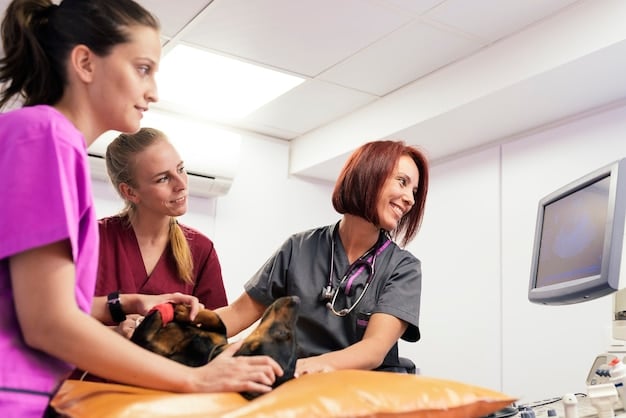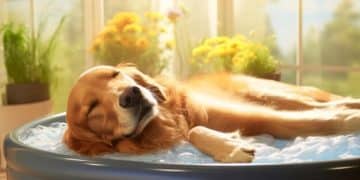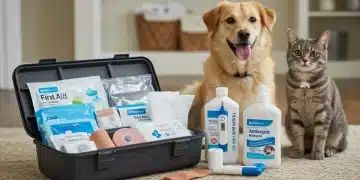Summer Heat Safety: Preventing Heatstroke in Dogs & Cats

Summer heat safety is crucial for preventing heatstroke in dogs and cats by ensuring they have access to fresh water, shade, and avoiding strenuous activities during peak heat hours.
As summer temperatures soar, ensuring **summer heat safety: how to prevent heatstroke in dogs and cats** becomes paramount. Our furry friends are particularly vulnerable to overheating, making it essential for pet owners to take proactive measures. Let’s dive into how you can keep your beloved companions safe and comfortable during the hottest months.
Understanding the Risks of Heatstroke in Pets
Heatstroke, also known as hyperthermia, is a severe condition that occurs when a pet’s body temperature rises to dangerous levels. Unlike humans, dogs and cats have limited ways to cool themselves down, making them more susceptible to overheating. Understanding the risks and recognizing the symptoms are the first steps in ensuring their well-being.
Why Pets are More Vulnerable to Heatstroke
Pets, especially dogs, rely heavily on panting to regulate their body temperature. However, this method is not as efficient as sweating, which humans use. Certain breeds, such as brachycephalic (short-nosed) dogs like Bulldogs and Pugs, have even greater difficulty cooling down due to their compromised respiratory systems. Cats, while more heat-tolerant than dogs, can still suffer from heatstroke, particularly if they are overweight, elderly, or have underlying health conditions.
Factors That Increase the Risk
Several factors can increase a pet’s risk of heatstroke. These include:
- High Environmental Temperatures: Days with extreme heat and humidity significantly elevate the risk.
- Lack of Shade and Water: Insufficient access to shade and fresh water makes it harder for pets to cool down.
- Strenuous Exercise: Intense physical activity during hot weather can quickly lead to overheating.
- Confinement in Enclosed Spaces: Leaving a pet in a parked car, even for a short time, can be deadly due to the rapid increase in temperature.
Being aware of these factors can help you take preventive measures and protect your pet from heatstroke.

Recognizing the risks associated with heatstroke is essential for proactive pet care, particularly during summer months. By understanding the vulnerabilities of different breeds and the environmental conditions that exacerbate these risks, pet owners can take the necessary steps to keep their companions safe and healthy.
Recognizing the Signs and Symptoms of Heatstroke
Early detection of heatstroke can be life-saving. Knowing the signs and symptoms allows you to take immediate action and seek veterinary care. The symptoms can vary in severity, but recognizing them early can make a significant difference in the outcome.
Common Symptoms to Watch For
Keep an eye out for the following symptoms:
- Excessive Panting or Rapid Breathing: This is often one of the first signs that your pet is overheating.
- Drooling: Increased saliva production can indicate discomfort and overheating.
- Weakness or Lethargy: Your pet may appear unusually tired or unable to stand.
- Vomiting or Diarrhea: Gastrointestinal distress can be a sign of heatstroke.
Severe Symptoms That Require Immediate Attention
If you notice any of the following severe symptoms, seek veterinary care immediately:
- Collapse: Sudden loss of consciousness is a critical sign.
- Seizures: Muscle tremors or convulsions indicate severe neurological distress.
- Bright Red or Blue Gums: Changes in gum color can indicate oxygen deprivation.
- Increased Heart Rate: A rapid heartbeat is a sign that the body is struggling to cool down.
Checking Your Pet’s Temperature
Using a rectal thermometer is the most accurate way to check your pet’s temperature. A normal temperature for dogs and cats is between 100°F and 102.5°F (37.8°C and 39.2°C). If your pet’s temperature is above 104°F (40°C), it is a medical emergency and requires immediate veterinary attention.
Recognizing the early and severe symptoms of heatstroke is vital for providing timely care. By being vigilant and knowing what to look for, you can take swift action to cool down your pet and seek professional help when necessary, increasing their chances of a full recovery.
Immediate First Aid for Heatstroke
If you suspect your pet is suffering from heatstroke, immediate first aid can help stabilize them until you can reach a veterinarian. The goal is to lower their body temperature gradually and prevent further damage. However, remember that first aid is not a substitute for professional veterinary care.
Steps to Take Before Reaching the Vet
Follow these steps to provide immediate relief:
- Move to a Cool Place: Get your pet out of the heat and into an air-conditioned or shaded area.
- Apply Cool Water: Use cool (not cold) water to wet your pet’s fur, especially around the ears, paws, and groin area. You can also use a fan to help evaporate the water.
- Offer Water to Drink: If your pet is conscious and able to drink, offer small amounts of cool water. Do not force them to drink.
What Not to Do
Avoid these common mistakes when providing first aid:
- Do Not Use Ice Water: Rapid cooling can cause shock and do more harm than good.
- Do Not Leave Your Pet Unattended: Monitor their condition closely and continue cooling efforts.
- Do Not Force Water: If your pet is unconscious or having difficulty swallowing, do not try to make them drink.
Importance of Professional Veterinary Care
Even if your pet seems to improve after first aid, it is essential to seek veterinary care. Heatstroke can cause internal damage to organs, and a veterinarian can assess the extent of the damage and provide appropriate treatment, such as IV fluids and monitoring. Delaying treatment can have serious consequences.

Immediate first aid can provide crucial initial support for a pet suffering from heatstroke. However, it is vital to remember that this is only a temporary measure. Professional veterinary care is essential to address the underlying damage and ensure the best possible outcome for your beloved companion.
Preventive Measures to Keep Your Pets Cool
Prevention is always better than cure. Taking proactive steps to keep your pets cool during the summer months can significantly reduce their risk of heatstroke. Simple changes to your daily routine and environment can make a big difference in their comfort and safety.
Providing Shade and Water
Ensure your pets have access to shade and fresh water at all times. When outdoors, provide a shaded area such as a tree, umbrella, or doghouse. Make sure their water bowl is always full and consider adding ice cubes to keep it cool. Indoor pets should also have access to cool water and a comfortable resting place away from direct sunlight.
Adjusting Exercise Routines
Avoid strenuous exercise during the hottest parts of the day. Opt for early morning or late evening walks when temperatures are cooler. Monitor your pet closely for signs of overheating and reduce the intensity of the activity if needed. Consider using a cooling vest or bandana to help them stay cool during walks.
Never Leave Pets in Parked Cars
Leaving a pet in a parked car, even with the windows cracked, is extremely dangerous. On a hot day, the temperature inside a car can rise rapidly to deadly levels within minutes. Always take your pet with you when you leave the car, or better yet, leave them at home where they can stay cool and comfortable.
Taking preventive measures is the most effective way to protect your pets from heatstroke. By providing shade and water, adjusting exercise routines, and never leaving them in parked cars, you can ensure they stay safe and comfortable throughout the summer months. These simple steps can make a significant difference in their well-being.
Creating a Pet-Friendly Summer Environment
A pet-friendly summer environment is one where your furry friends can thrive without being exposed to excessive heat. By making a few adjustments to your home and lifestyle, you can create a haven for your pets during the summer months. Consider the following tips to enhance their comfort and safety.
Indoor Cooling Strategies
Keep your home cool by using air conditioning, fans, or window coverings to block out direct sunlight. Provide your pets with cool, comfortable resting spots, such as tile floors or cooling mats. Offer frozen treats, such as ice cubes with bits of fruit or pet-friendly broth, to help them stay hydrated and cool.
Outdoor Safety Tips
When spending time outdoors with your pets, be mindful of the ground temperature. Asphalt and concrete can get extremely hot and burn their paws. Walk them on grass or use paw protectors. Provide a shallow pool or sprinkler for them to play in and cool off. Always supervise them closely to prevent accidents or overheating.
Creating a pet-friendly summer environment involves both indoor and outdoor considerations. By implementing cooling strategies and taking safety precautions, you can ensure your pets remain comfortable and healthy throughout the summer season. These adjustments will help them enjoy the warm weather without the risk of heatstroke.
Breed-Specific Considerations for Heat Safety
Certain breeds are more susceptible to heatstroke than others due to their physical characteristics. Understanding these breed-specific considerations can help you tailor your approach to **summer heat safety** and provide the best possible care for your pets.
Brachycephalic Breeds
Brachycephalic breeds, such as Bulldogs, Pugs, and Persian cats, have shortened nasal passages, which makes it difficult for them to cool down through panting. These breeds require extra attention during hot weather. Keep them indoors in air-conditioned environments and avoid strenuous exercise. Use cooling collars and vests to help them stay cool.
Long-Haired Breeds
Long-haired breeds, such as Huskies, Newfoundlands, and long-haired cats, have thick coats that can trap heat. Regular grooming is essential to remove excess fur and improve air circulation. Consider trimming their coats slightly during the summer months to help them stay cooler. Provide them with access to shaded areas and cool water at all times.
- Monitor closely: Watch for signs of overheating.
- Provide extra hydration: Ensure constant access to cool water.
- Adjust activities: Limit outdoor time during peak heat.
Breed-specific considerations are crucial for ensuring effective heat safety for pets. By understanding the unique vulnerabilities of different breeds and implementing tailored strategies, you can provide the best possible care and protect them from heatstroke.
| Key Point | Brief Description |
|---|---|
| 💧 Hydration | Ensure constant access to fresh, cool water. |
| 🌳 Shade | Provide shade outdoors and cool spots indoors. |
| 🚗 Parked Cars | Never leave pets in parked cars, even briefly. |
| 🌡️ Monitoring | Watch for signs of heatstroke like excessive panting. |
Frequently Asked Questions
▼
Early signs include excessive panting, drooling, weakness, and rapid breathing. These symptoms indicate your pet is struggling to regulate its body temperature and needs immediate attention.
▼
Move your pet to a cool place, apply cool water to their fur (especially around the ears and paws), and offer small amounts of cool water if they are conscious. Avoid using ice water.
▼
No, it is never safe. The temperature inside a parked car can rise rapidly, even with the windows cracked, leading to heatstroke and potentially death within minutes.
▼
Brachycephalic breeds (short-nosed) like Bulldogs and Pugs, and long-haired breeds like Huskies, are more prone to heatstroke due to their physical characteristics that hinder effective cooling.
▼
Ensure your pet has constant access to fresh, cool water. Check their water bowl frequently and refill as needed, especially during hot weather and after physical activity.
Conclusion
Ensuring **summer heat safety** for your dogs and cats is a responsibility that requires awareness, preparation, and quick action. By understanding the risks, recognizing the symptoms of heatstroke, and implementing preventive measures, you can keep your beloved pets safe and comfortable throughout the summer months. Remember, a little extra care can make a big difference in their well-being.





